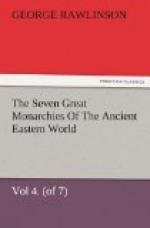The domestic animals employed in the countries which composed the Empire were, camels, horses, mules, asses, buffaloes, cows and oxen, goats, sheep, and dogs. Mules as well as horses seem to have been anciently used in war by the people of the more southern regions-by the Susianians at any rate, if not also by the Babylonians. Sometimes they were ridden; sometimes they were employed to draw carts or chariots. They were spirited and active animals, evidently of a fine breed, such as that for which Khuzistan is famous at the present day. [Plate. VIII., Fig. 4.] The asses from which these mules were produced must also have been of superior quality, like the breed for which Baghdad is even now famous, The Babylonian horses are not likely to have been nearly so good; for this animal does not flourish in a climate which is at once moist and hot. Still, at any rate under the Persians, Babylonia seems to have been a great breeding-place for horses, since the stud of a single satrap consisted of 800 stallions and 16,000 mares. If we may judge of the character of Babylonian from that of Susianian steeds, we may consider the breed to have, been strong and large limbed, but not very handsome, the head being too large and the legs too short for beauty. [Plate IX., Fig. 1.]
[Illustration: Plate IX.]
The Babylonians were also from very early times famous for their breed of dogs. The tablet engraved in a former volume, which gives a representation of a Babylonian hound, is probably of a high antiquity, not later than the period or the Empire. Dogs are also not unfrequently represented on ancient Babylonian stones and cylinders. It would seem that, as in Assyria, there were two principal breeds, one somewhat clumsy and heavy, of a character not unlike that of our mastiff, the other of a much lighter make, nearly resembling our greyhound. The former kind is probably the breed known as Indian, which was kept up by continual importations from the country whence it was originally derived.[Plate. IX., Fig. 2.]
We have no evidence that camels were employed in the time of the Empire, either by the Babylonians themselves or by their neighbors, the Susianians; but in Upper Mesopotamia, in Syria, and in Palestine they had been in use from a very early date. The Amalekitos and the Midianites found them serviceable in war; and the latter people employed them also as beasts of burden in their caravan trade. The Syrians of Upper Mesopotamia rode upon them in their journeys. It appears that they were also sometimes yoked to chariots, though from their size and clumsiness they would be but ill fitted for beasts of draught.




